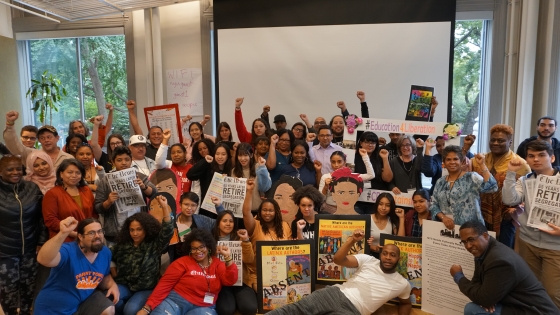Introduction
In New York City, the birthplace of the Harlem Renaissance and the Nuyorican Movement, home to as many as 800 languages, one might expect public schools to be teaching children books by and about the exceptionally diverse communities and cultures that surround us.2 But that is not the case.While only 15% of NYC public school students are white, the authors of books in commonly-used elementary school curriculum are, on average, 84% white—a percentage more fitting for Bismarck, North Dakota (82% white) or Dubuque, Iowa (80% white) than New York City. (3)
Over the past several years, the NYC Coalition for Educational Justice (CEJ) has been engaged in a Campaign for Culturally Responsive Education. In October 2018, CEJ released an analysis of three commonly-used NYC curricula and booklists and called on the NYC Department of Education (DOE) to revamp curriculum to reflect the diversity of NYC students.4 NYC Chancellor Carranza has been a champion of culturally responsive education throughout his career and was recently quoted saying, “Culturally relevant education brings learning to life for students. Learning about authors, leaders, great people who look like they do, who grew up like they did, can propel children to success.”5 Over the past few years, the city has elevated issues of diversity and integration in NYC schools, and Mayor de Blasio has said, “Our schools are best when they reflect the diversity of our city”. But these efforts will have limited impact if the academic content is not culturally responsive and does not represent the diversity of NYC students.
Culturally responsive education (CRE) is a cultural view of learning and human development in which multiple forms of diversity (e.g., race, social class, gender, language, sexual orientation, nationality, religion, ability) are recognized as indispensable sources of knowledge for teaching and learning, and assets that contribute to positive academic outcomes. CRE cultivates critical thinking instead of just test-taking skills, relates academic study to contemporary issues and students’ experiences; fosters positive academic, racial and cultural identities; develops students’ ability to connect across cultures; empowers students as agents of social change and inspires students to fall in love with learning.
Research demonstrates that for students of color and white students, CRE decreases dropout rates and suspensions, and increases grade point averages, student participation, self-image, critical thinking skills and graduation rates.6 Research from Tucson, AZ showed that students who took Mexican American Studies classes scored better in Math, Reading and Writing, and were significantly more likely to graduate from high school—and low-income and academically struggling students made the largest gains. Students were more engaged in literature and history lessons, and more likely to have a positive perception of their ability to succeed in math and science. (7) Recent research from the San Francisco Unified School District showed that 9th graders who took Ethnic Studies courses improved their attendance on average by 21 percentage points, their GPA by 1.4 grade points, and their earned credits by 23 credits. (8)
Clearly, when executed effectively, culturally responsive education has a positive impact on students of all cultural backgrounds. In a school system where 85% of students identify as Black, Latinx, or Asian, during a historical period when communities of color and immigrant communities are under political attack, a culturally responsive curriculum is essential.
Chronically Absent: The Exclusion of People of Color from NYC Elementary School Curricula
Use the button below to download the full report
Full Report
